Sometime between midnight and dawn Sunday morning, rock royalty took the Woodstock stage. Janis Joplin glided to the microphone in her tie-dyed velvet bellbottoms and blouse, her soulful, tortured voice, and, to some people’s disappointment, without Big Brother & The Holding Company.
Day Two, Performer 11: Janis Joplin
Performed Sunday morning, August 17, 2:30–3:30 am
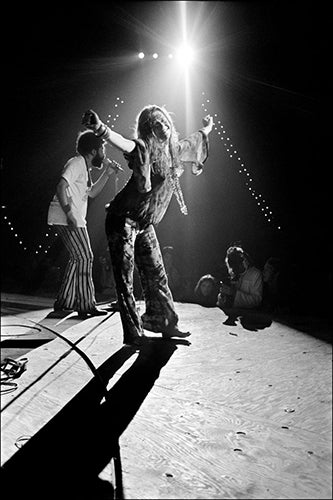
Janis Joplin struts for the audience on the Woodstock stage as Snooky Flowers takes a break from the sax to sing. Photo © Elliott Landy.
Janis Joplin Band Members
- Janis Joplin: vocals
- Terry Clements: tenor saxophone
- Cornelius "Snooky" Flowers: baritone saxophone
- Luis Gasca: trumpet
- John Till: guitar
- Richard Kermode: keyboards
- Brad Campbell: bass
- Maury Baker: drums
Janis Joplin Woodstock Setlist
- Raise Your Hand
- As Good as You've Been To This World
- To Love Somebody
- Summertime
- Try (Just a Little Bit Harder)
- Kozmic Blues
- Can't Turn You Loose
- Work Me, Lord
- Piece of My Heart
- Ball and Chain
Janis Joplin’s career and rise to the top are well-known. Born in Port Arthur, Texas to a typically conservative southern family, Janis was something of the ultimate outsider in school—she was relentlessly bullied, but eventually, she found some peace in the company of a group of fellow outsiders with a taste for the blues. With a head full of blues legends like Bessie Smith, Ma Rainey, and Big Mama Thornton, Janis began to sing in small clubs, quickly developing an emotive blues wail far removed from her influences or, in fact, from anything ever heard before. She also began experimenting with drugs around this time.
In 1963, Janis hitchhiked with her friend Chet Helms (who would go on to become one of the Bay Area’s major concert promoters) to San Francisco, where she continued to hone her performing style. Finding kindred spirits in the company of area musicians such as Jorma Kaukonen (who would go on to be the lead guitarist for the Jefferson Airplane), Janis cultivated a reputation as an explosive blues singer and a “bad girl” with a major taste for hard drugs like methamphetamine and heroin. In 1965, at the urging of her friends who were concerned that her drug intake might lead her to a bad end, Janis returned to Texas. For a time, she attended classes at Lamar University and avoided drugs and alcohol, while still performing small club gigs in Austin, accompanying herself on acoustic guitar.
Through her connection with Chet Helms, Janis was called back to San Francisco in 1966 to front one of the Bay Area’s hottest psychedelic rock bands. She fronted Big Brother & The Holding Company as lead singer as they played dance concerts at all the popular venues, especially Fillmore Auditorium. Her raw, powerful voice made her and her band instant stars. When Big Brother played the Monterey International Pop Festival in June 1967, filmmaker D.A. Pennebaker didn’t bother to film them for his documentary, Monterey Pop, but their performance was so strong and well-received by the audience, festival promoters convinced them to perform again the next day. Captured by Pennebaker, Joplin’s performance amazed and delighted and made Janis Joplin a household name.
As one of the leading lights of the San Francisco music scene, the band was poised for major success early on. Unsurprisingly, they were quickly signed to the small Mainstream Records label, who released their self-titled debut album in August 1967, spawning a minor hit single with “Down On Me.”
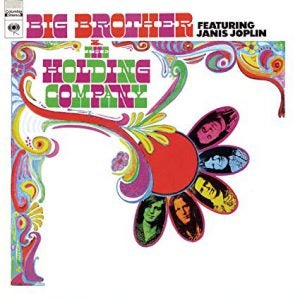
the self-titled
debut album of
Big Brother & The Holding Company (1967).
As the band’s reputation began to spread, their Mainstream contract was bought out by Columbia Records, who issued the second Big Brother album, Cheap Thrills, in August 1968. This gave the band a massive hit single with Janis’ classic take on Erma Franklin’s “Piece Of My Heart,” and the band instantly rose to greater fame, with Janis assuming her rightful place in the pantheon of rock royalty. Unfortunately, by this time Janis had become dissatisfied with her work in Big Brother, a situation exacerbated by the use (by both Janis and her bandmates) of hard drugs such as heroin.
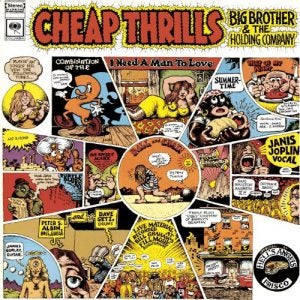
established the band, especially its lead singer,
Janis Joplin, as stars.
By the time Woodstock happened in August 1969,
Janis had left the band to pursue her solo career.
At the urging of record executives. Janis left Big Brother in late 1968. Influenced by soul giants such as Otis Redding, she wanted to move in a more R&B direction, deciding to add a horn section to her new newly-formed band. This consisted of some of the best Bay Area session musicians, as well as former Big Brother guitarist Sam Andrew (who would leave the band within a few months, due to his drug use and influence on Janis). Calling themselves The Kozmic Blues Band, they began touring in early 1969. By this time, Janis’ heroin dependency was becoming a serious problem for her, with her minders attempting to keep her clean long enough to record her first solo album, I Got Dem Ol’ Kozmic Blues Again Mama!, in June 1969. The album would not be released until September, and as a result, Janis took to the stage at Woodstock with a new sound and some new music the audience had never heard.
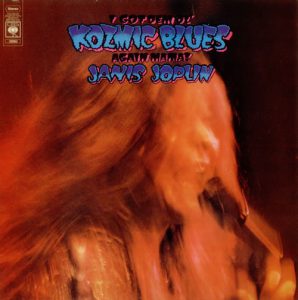
I Got Dem Ol' Kozmic Blues Again Mama! (1969),
though recorded before Woodstock, was
not released until after the festival.
As a result, attendees were unfamiliar with much
of her Woodstock set.
One of the most anticipated acts to play at Woodstock, Janis was completely overwhelmed by the size of the audience. As a result, Janis spent most of the day backstage getting fairly ripped, and consequently was not in the best shape by the time she took the stage at 2:00 am on Sunday morning. Janis and her Kozmic cronies opened with a cover of Eddie Floyd’s “Raise Your Hand,” a suitably up-tempo stomp that showcased the new sound full-bore. Janis worked the groove hard, attempting to establish a rapport with the vast audience. A tune from her forthcoming album followed with Nick Gravenites’ “As Good As You’ve Been To This World,” after which Janis took the mood down a notch for an excellent rendition of the recent Bee Gees’ hit “To Love Somebody,” which would also be on her new album.
Taking it into familiar (to the Woodstock audience) territory for the first time in the set, Janis gave the crowd a soothing rendition of George Gershwin’s “Summertime,” which had been an FM radio staple following its release on the 1968 Big Brother album Cheap Thrills. With the crowd now in her corner, Janis cranked up the energy once again with “Try (Just A Little Bit Harder),” which would become the biggest hit off her forthcoming album. A stunning rendition of the ballad “Kozmic Blues” (again from the new album) followed and was probably the best-received of the new tunes that dominated the set.
Looking to have some fun, Janis turned the microphone over to her tenor sax man Snooky Flowers, who showed what The Kozmic Blues Band could really do in a stomping rendition of Otis Redding’s “Can’t Turn You Loose.” Snooky and Janis flailed about the stage ecstatically, with Janis seemingly happy with the proceedings at last. This paved the way for the final number of the main set, a rendition of Nick Gravenites’ heartrending “Work Me, Lord.” This featured a breakdown section near the end where Janis wailed unaccompanied into the night, giving of herself until her already-brittle voice finally gave out.
Coaxed back onto the stage by a rapturous response from the crowd, Janis closed her Woodstock performance with a pair of tunes from the Cheap Thrills album. First up was “Piece Of My Heart,” which had been Janis’ biggest hit single to date and was rearranged here into an almost unrecognizable up-tempo groove. The set closed with Janis’ classic arrangement of Big Mama Thornton’s “Ball And Chain,” during which an impassioned Pearl left everything she had on that stage with another tormented, unaccompanied climax.
Joplin’s Woodstock set with The Kozmic Blues Band wasn’t received well by some critics and fans who were expecting the more raw, psychedelic rock sound of her former group, but a close examination of their performance shows the energy, emotion, and musicality of the set. Janis Joplin was in total control of the stage and the music, and she gave everything she had that night. Perhaps because of the naysayers, or perhaps for other unknown reasons, Janis Joplin’s Woodstock set was not included in the Woodstock movie or soundtrack. The omission was corrected in later cuts of the movie and other compilations of the music, but Janis was missing from the official record of the time.
After Woodstock, Janis Joplin continued to experiment with her music. She brought together a new band, this time without horns, which she called The Full Tilt Boogie Band, and continued to amaze audiences with her vocal abilities and song interpretations. Brad Campbell, bass player at Woodstock, continued to work with Janis until the end, as did her Woodstock guitarist John Till. The other members of The Kozmic Blues Band went their separate ways, each continuing to perform with a variety of top musicians.
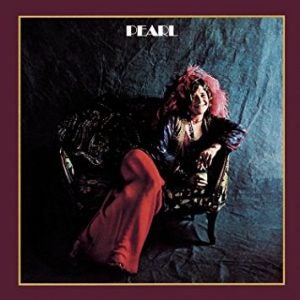
released posthumously and was the
largest-selling album of her career.
From late August to early October 1970, Janis and her band rehearsed and began recording a new album. Sadly, her addiction caught up with her at last and she died October 4, 1970, of an accidental heroin overdose. Her second and last solo album, Pearl, was released posthumously the following year. It became the best-selling album of her career and signaled another, more mature and thoughtful change of musical direction for the world-weary singer, spawning a classic hit single in her cover of Kris Kristofferson’s “Me And Bobby McGee.”
—Wade Lawrence & Scott Parker
